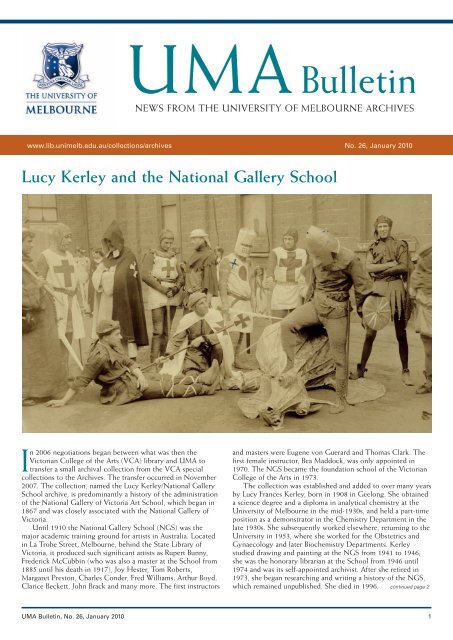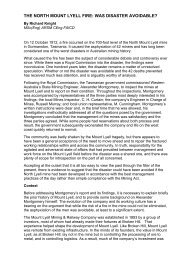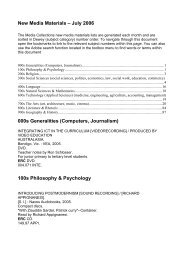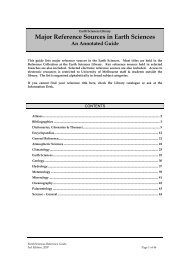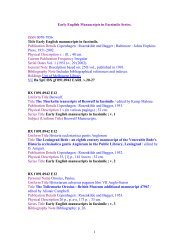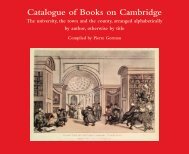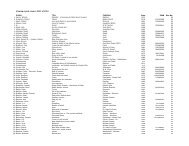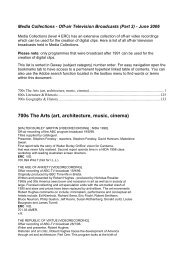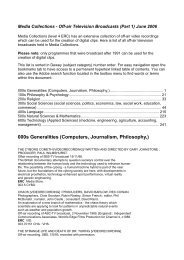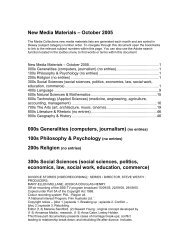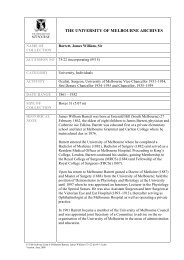UMABulletin UMABulletin - The University of Melbourne Library
UMABulletin UMABulletin - The University of Melbourne Library
UMABulletin UMABulletin - The University of Melbourne Library
Create successful ePaper yourself
Turn your PDF publications into a flip-book with our unique Google optimized e-Paper software.
UMA UMA Bulletin Bulletin<br />
NEWS FROM THE UNIVERSITY OF MELBOURNE ARCHIVES<br />
www.lib.unimelb.edu.au/collections/archives No. 26, January 2010<br />
Lucy Kerley and the National Gallery School<br />
In 2006 negotiations began between what was then the<br />
Victorian College <strong>of</strong> the Arts (VCA) library and UMA to<br />
transfer a small archival collection from the VCA special<br />
collections to the Archives. <strong>The</strong> transfer occurred in November<br />
2007. <strong>The</strong> collection, named the Lucy Kerley/National Gallery<br />
School archive, is predominantly a history <strong>of</strong> the administration<br />
<strong>of</strong> the National Gallery <strong>of</strong> Victoria Art School, which began in<br />
1867 and was closely associated with the National Gallery <strong>of</strong><br />
Victoria.<br />
Until 1910 the National Gallery School (NGS) was the<br />
major academic training ground for artists in Australia. Located<br />
in La Trobe Street, <strong>Melbourne</strong>, behind the State <strong>Library</strong> <strong>of</strong><br />
Victoria, it produced such significant artists as Rupert Bunny,<br />
Frederick McCubbin (who was also a master at the School from<br />
1885 until his death in 1917), Joy Hester, Tom Roberts,<br />
Margaret Preston, Charles Conder, Fred Williams, Arthur Boyd,<br />
Clarice Beckett, John Brack and many more. <strong>The</strong> first instructors<br />
and masters were Eugene von Guerard and Thomas Clark. <strong>The</strong><br />
first female instructor, Bea Maddock, was only appointed in<br />
1970. <strong>The</strong> NGS became the foundation school <strong>of</strong> the Victorian<br />
College <strong>of</strong> the Arts in 1973.<br />
<strong>The</strong> collection was established and added to over many years<br />
by Lucy Frances Kerley, born in 1908 in Geelong. She obtained<br />
a science degree and a diploma in analytical chemistry at the<br />
<strong>University</strong> <strong>of</strong> <strong>Melbourne</strong> in the mid-1930s, and held a part-time<br />
position as a demonstrator in the Chemistry Department in the<br />
late 1930s. She subsequently worked elsewhere, returning to the<br />
<strong>University</strong> in 1953, where she worked for the Obstetrics and<br />
Gynaecology and later Biochemistry Departments. Kerley<br />
studied drawing and painting at the NGS from 1941 to 1946;<br />
she was the honorary librarian at the School from 1946 until<br />
1974 and was its self-appointed archivist. After she retired in<br />
1973, she began researching and writing a history <strong>of</strong> the NGS,<br />
which remained unpublished. She died in 1996. continued page 2<br />
UMA Bulletin, No. 26, January 2010 1
Kerley was passionate about the School and actively<br />
collected everything associated with it, including student rolls<br />
and registers, student magazines, minutes, correspondence,<br />
newspaper cuttings, exhibition catalogues, original drawings<br />
and sketches, programs, account books and ephemera.<br />
<strong>The</strong> correspondence in the archive is extensive. A particular<br />
exchange demonstrates her obvious dedication and<br />
commitment, not to mention her strong personality. A letter<br />
from 1984 from the director David Muir requests information<br />
from Kerley for his planned film about the NGS. <strong>The</strong> response<br />
is polite, yet somewhat terse. Although she answers his queries,<br />
she adds ‘When my book is published … then you may use my<br />
book and all its references as much as you like, but you should<br />
not expect to have my work (before publication) handed to you<br />
for your use.’ A perusal <strong>of</strong> Muir’s filmography suggests that this<br />
film was never made.<br />
Fifty-seven chronological exercise books contain Kerley’s<br />
extensive, if sometimes unintelligible, research notes, which are<br />
interspersed with doodles and ephemera. Her notes cover events<br />
related to the NGS and include handwritten transcripts from<br />
2<br />
primary sources. Some <strong>of</strong> these were ‘re-summarized and typed’<br />
by her. <strong>The</strong>re are also draft chapters <strong>of</strong> her manuscript, covering<br />
1856 to 1962.<br />
A series <strong>of</strong> newspaper clippings from the 1960s details the<br />
students’ stories <strong>of</strong> near poverty and having to work at jobs such<br />
as peeling potatoes and shows images <strong>of</strong> students labouring at<br />
their easels. From the early days the School awarded prizes and<br />
scholarships to its students, who inevitably struggled to make<br />
ends meet while they studied. <strong>The</strong> School’s ‘Women’s<br />
Committee for Student Welfare’ awarded the scholarships and<br />
was active in looking for donors to the School.<br />
Various incarnations <strong>of</strong> student magazines were created by<br />
the students from 1917 to 1961. <strong>The</strong> first was ‘Light and Shade’,<br />
containing articles, poetry, cartoons, student news and gossip,<br />
advertisements and original student artwork. ‘Colour on Parade:<br />
National Art Gallery Student Magazine’ was produced in 1945<br />
and again in 1946 with Kerley as the editor. It became ‘Daub’ in<br />
1947 and was published annually until 1961, although the series<br />
in the archive is incomplete. Access to some <strong>of</strong> this part <strong>of</strong> the<br />
collection is restricted due to its extreme fragility; a research<br />
UMA Bulletin, No. 26, January 2010
grant is currently being sought to photograph these, so as to<br />
enable researcher access.<br />
Approximately 20 <strong>of</strong> the photographs have been digitised.<br />
Many <strong>of</strong> them show groups <strong>of</strong> students in formal class portraits<br />
or dressed up and larking around for costume parties and balls.<br />
Arty interiors, <strong>Melbourne</strong> streetscapes, and landscapes can also<br />
be seen in the images.<br />
<strong>The</strong> history <strong>of</strong> art schools and galleries has been somewhat<br />
neglected until recently. With a research grant from the<br />
National Archives <strong>of</strong> Australia, archivists Eileen Chanin and<br />
Steven Miller began a project in 2006 to identify the ‘lost’<br />
archival records <strong>of</strong> Australia’s art schools and make them<br />
accessible via a database (see http://www.naa.gov.au/aboutus/<br />
research-grants/ian-maclean/former-awards/index.aspx). <strong>The</strong><br />
procurement and listing <strong>of</strong> the Kerley/NGS archive contributes<br />
to the corpus <strong>of</strong> knowledge in this area; indeed, completion <strong>of</strong><br />
the history <strong>of</strong> the NGS, as Kerley so fervently desired, would<br />
make an excellent research project.<br />
Stephanie Jaehrling<br />
Publications, <strong>University</strong> <strong>Library</strong><br />
Front page: National Gallery School Students’ Ball, n.d.<br />
Clockwise from top left: A group <strong>of</strong> students from the NGS, gathered<br />
under the statue <strong>of</strong> Joan <strong>of</strong> Arc, on the forecourt <strong>of</strong> the State <strong>Library</strong> <strong>of</strong><br />
Victoria, Swanston Street, <strong>Melbourne</strong>. ‘Copied from original snap shot<br />
taken in the 1920s (circa 1920)’ is written in ink on the back <strong>of</strong> the<br />
photograph. An ink sketch on tracing paper accompanies the photo and<br />
identifies some students including Roy Thompson and Madge Freeman;<br />
Students and teachers at a life drawing class in 1916, at the NGS.<br />
Herbert Rose is second from the right and Bernard Hall is possibly<br />
second from the left; Judy Hunter and David Boyd holding mops in the<br />
courtyard <strong>of</strong> the National Gallery <strong>of</strong> Victoria in 1945. Both were students<br />
at the NGS; <strong>The</strong> artist Herbert Rose seated at his easel, painting in an<br />
Australian bush location in 1924. Rose was formally a student <strong>of</strong> the<br />
NGS; An indoor posed group <strong>of</strong> students in fancy dress at an NGS<br />
Students’ Fancy Dress Ball, prior to 1914.<br />
UMA Bulletin, No. 26, January 2010 3
Mining UMA Collections for Foresters at the <strong>University</strong><br />
For much <strong>of</strong> the 20th century the<br />
Forests Commission <strong>of</strong> Victoria<br />
(FCV) controlled forestry in Victoria.<br />
For decades Victoria’s sole employer <strong>of</strong><br />
foresters, the FCV trained foresters at its<br />
School <strong>of</strong> Forestry at Creswick and sent<br />
some for further studies at the <strong>University</strong><br />
<strong>of</strong> <strong>Melbourne</strong>.<br />
During my historical investigations <strong>of</strong><br />
the <strong>University</strong>’s Botany School I couldn’t<br />
help noticing foresters — they <strong>of</strong>ten<br />
starred in botany exams. And so, for the<br />
approaching centenary <strong>of</strong> the Creswick<br />
School <strong>of</strong> Forestry, I decided to examine<br />
the <strong>University</strong>’s intellectual relationship<br />
with the Creswick School.<br />
But how to find foresters among<br />
<strong>Melbourne</strong> <strong>University</strong>’s numerous<br />
students? When the <strong>University</strong> provided<br />
a degree specifically for foresters — the<br />
Bachelor <strong>of</strong> Science in Forestry (BScF)<br />
degree — graduation lists in the now<br />
digitised (hooray!) <strong>Melbourne</strong> <strong>University</strong><br />
Calendars provide the names <strong>of</strong> BScF<br />
graduates — well, most <strong>of</strong> them. However,<br />
before the <strong>University</strong> provided their BScF<br />
course in the 1940s, a trickle <strong>of</strong> Creswicktrained<br />
foresters took the Bachelor <strong>of</strong><br />
Science (BSc) degree. <strong>The</strong>y studied<br />
botany which, under Pr<strong>of</strong>essor Alfred<br />
Ewart, was, from 1914, taught in first,<br />
second and third years as Botany Parts I,<br />
II and III. Pr<strong>of</strong>essor Ewart was also the<br />
long-serving chairman <strong>of</strong> the examination<br />
board that was responsible for maintaining<br />
standards in the Creswick School.<br />
I have spent many hours in the<br />
<strong>University</strong> Archives repository in Dawson<br />
Street, trawling through the huge leatherbound<br />
volumes <strong>of</strong> <strong>University</strong> examination<br />
records in search <strong>of</strong> the names <strong>of</strong> Botany<br />
Part III students across the decades. I<br />
recognised the names <strong>of</strong> two Creswick<br />
graduates — John Harding Chinner, who<br />
would later head the <strong>University</strong>’s School<br />
<strong>of</strong> Forestry, and James Hamlyn Willis,<br />
who left the FCV to work in the National<br />
Herbarium and would write A Handbook to<br />
Plants in Victoria, the indispensable<br />
successor to Ewart’s Flora <strong>of</strong> Victoria. To<br />
find out more about their undergraduate<br />
studies, I sought the student records <strong>of</strong><br />
the late John Chinner and Jim Willis.<br />
Each had honours in Botany Parts II and<br />
III and an exhibition.<br />
Wondering whether other Botany Part<br />
III students were Creswick graduates, I<br />
consulted Frank Moulds’ appendix,<br />
‘Graduates <strong>of</strong> the Creswick School <strong>of</strong><br />
Forestry’, in his book, <strong>The</strong> Dynamic Forest:<br />
A history <strong>of</strong> forestry and forest industries in<br />
Victoria, and found the names <strong>of</strong> 12 Part<br />
4<br />
III examinees in the 1930s. All but one<br />
had honours; seven had the sometimes<br />
shared exhibition. But someone was<br />
missing — Frank Moulds, whose FCV<br />
positions would include Creswick School<br />
principal and FCV chairman. In his<br />
contribution to Cambridge–Castlemaine: A<br />
tribute to John Stewart Turner on the occasion <strong>of</strong><br />
his 80th birthday, Moulds commented that<br />
he first met Pr<strong>of</strong>essor Turner (Ewart’s<br />
recently-arrived successor) when he,<br />
Frank, ‘was completing a science degree<br />
at the <strong>University</strong> <strong>of</strong> <strong>Melbourne</strong> in 1939’.<br />
So why was Frank Moulds not a Botany<br />
Part III examinee that year?<br />
Nilufer Aylav helped me find the<br />
answer. She introduced me to a resource I<br />
should have known about — botany<br />
examination results and papers. Now I<br />
could easily peruse Botany Part II and III<br />
records. And there was Frank Moulds —<br />
passing Botany Part II (not III) in 1939.<br />
Unlike his dozen fellow Creswick<br />
graduates, Moulds majored in chemistry<br />
instead <strong>of</strong> botany.<br />
Moulds’ student record card carries a<br />
handwritten note, ‘Granted exemption<br />
from 1st year <strong>of</strong> the course for BSc’. Like<br />
Chinner and Willis, Moulds gained a BSc<br />
degree after two university years. As<br />
explained in <strong>Melbourne</strong> <strong>University</strong> Calendars,<br />
from 1929,<br />
a matriculated student who has completed a<br />
three years’ course at the School <strong>of</strong> Forestry<br />
Creswick may on the recommendation <strong>of</strong><br />
the Technical Colleges Board be admitted<br />
to the Second Year <strong>of</strong> the course for the<br />
Degree <strong>of</strong> Bachelor <strong>of</strong> Science and on<br />
completion <strong>of</strong> the Second and Third Years<br />
<strong>of</strong> a course approved in each such case by<br />
the [Science] Faculty … may be admitted<br />
to the Degree <strong>of</strong> Bachelor <strong>of</strong> Science. 1<br />
<strong>The</strong> <strong>University</strong>’s Technical Colleges<br />
Board determined the standards and status<br />
<strong>of</strong> College diploma subjects and courses,<br />
including those <strong>of</strong> the Creswick School<br />
<strong>of</strong> Forestry. But why did the <strong>University</strong><br />
recognise the Creswick diploma course at<br />
this particular time?<br />
In the 1920s the FCV was anxious to<br />
pr<strong>of</strong>essionalise forestry and wanted access<br />
to tertiary qualifications for its better<br />
Creswick students. Documents in that<br />
information-rich UMA collection, the<br />
Central Registry correspondence, show<br />
that several Creswick-trained foresters<br />
studied at the <strong>University</strong> in the 1920s and<br />
that the FCV was dissatisfied with their<br />
treatment. In 1927 the FCV chairman<br />
complained that several Creswick-trained<br />
BSc students had had to repeat work<br />
already done at Creswick ‘for which the<br />
<strong>University</strong> was not prepared to grant<br />
exemption’. He wanted the <strong>University</strong> to<br />
recognise the three-year diploma course<br />
and grant exemptions from Part I Botany,<br />
Geology and Chemistry. 2<br />
Inspectors appointed by the Technical<br />
Colleges Board reported on the Creswick<br />
course in 1928. Not surprisingly, given<br />
Ewart’s long association with Creswick<br />
School, the standard <strong>of</strong> botany was<br />
considered satisfactory. Students granted<br />
the School’s diploma were considered<br />
‘well qualified to proceed directly to the<br />
2nd Year work in Botany at the<br />
<strong>University</strong>’. <strong>The</strong>y ‘could be exempted<br />
from Botany Part I’, but other subjects<br />
required improvement to bring them up<br />
to first-year <strong>University</strong> standard. <strong>The</strong><br />
inspectors recommended that, when the<br />
Science Faculty could accept an improved<br />
Creswick course as ‘substantially fulfilling<br />
the requirements <strong>of</strong> 1st Year Science’, it<br />
should ‘introduce legislation into the<br />
Regulations for the Science Degree to<br />
give such students, on the<br />
recommendation <strong>of</strong> the Technical<br />
Colleges Board, the status <strong>of</strong> 2nd Year<br />
Science students’. 3 <strong>The</strong> <strong>University</strong><br />
subsequently passed legislation allowing<br />
students with a Creswick diploma ‘to be<br />
given the status <strong>of</strong> 2nd Year students in<br />
this <strong>University</strong>, and to complete the<br />
Science Degree in two years <strong>of</strong> study<br />
with approved subjects’. 4<br />
And so John Chinner, Jim Willis,<br />
Frank Moulds and other Creswick<br />
graduates could undertake second- and<br />
third-year BSc studies in the 1930s. But<br />
this is not the full story. It is but part <strong>of</strong> a<br />
complexity <strong>of</strong> forestry discussions<br />
involving the FCV, the Australian<br />
Forestry School (AFS) in Canberra and<br />
the universities <strong>of</strong> Adelaide and<br />
<strong>Melbourne</strong> in the 1920s. <strong>The</strong> <strong>Melbourne</strong><br />
<strong>University</strong> Council and Science Faculty<br />
disagreed. <strong>The</strong> Council supported an<br />
AFS-linked BScF degree sought by the<br />
AFS. Despite faculty arguments against a<br />
degree being awarded for studies over<br />
whose second half the <strong>University</strong> had no<br />
control, from 1931 the <strong>University</strong> <strong>of</strong>fered<br />
a BScF degree with two years <strong>of</strong> AFS<br />
forestry studies following two years <strong>of</strong><br />
<strong>University</strong> science studies. <strong>The</strong> FCV<br />
would have nothing to do with such a<br />
degree. Instead it sent a succession <strong>of</strong><br />
Creswick-trained foresters for BSc studies<br />
and <strong>of</strong>fered to fund a forestry lectureship<br />
to help <strong>Melbourne</strong> <strong>University</strong> establish a<br />
forestry course for Creswick graduates.<br />
UMA Bulletin, No. 26, January 2010
Meanwhile, only two (non-FCV) students<br />
took the AFS-linked BScF course.<br />
Record cards for Creswick-trained BSc<br />
students reveal more than the subjects<br />
they studied and their examination<br />
results. Penned comments include<br />
Technical Colleges Board and Science<br />
Faculty information about exemptions<br />
granted and courses allowed. Students<br />
from Creswick in the 1920s (before the<br />
<strong>University</strong> recognised the diploma<br />
course) were granted only a single<br />
exemption — Botany Part I. Record cards<br />
for Willis, Chinner, Moulds and other<br />
later Creswick students confirm that they<br />
were admitted to second-year BSc studies.<br />
Eventually, in the early 1940s, the<br />
<strong>University</strong> followed Science Faculty<br />
recommendations to accept the FCV’s<br />
<strong>of</strong>fer and provide a course designed<br />
specifically for Creswick graduates. It was<br />
a new course for the BScF degree. From<br />
1942, the <strong>Melbourne</strong> <strong>University</strong> Calendar<br />
carried descriptions <strong>of</strong> two BScF courses<br />
— the rarely taken AFS-linked course and<br />
the new Creswick-based course which<br />
was undertaken by increasing numbers <strong>of</strong><br />
FCV foresters.<br />
<strong>Melbourne</strong> <strong>University</strong> Calendars and UMA<br />
collections have enabled me to gain some<br />
understanding <strong>of</strong> the <strong>University</strong>’s<br />
changing intellectual relationship with<br />
the Creswick School <strong>of</strong> Forestry. Now I<br />
know why Creswick-trained foresters<br />
undertook BSc studies in the 1930s and<br />
BScF studies from the 1940s. Of course I<br />
was aided by more than the collections.<br />
Intelligent and perceptive archivists and<br />
librarians have tolerated and responded to<br />
my sometimes repetitive questions, even<br />
occasionally providing crucial material<br />
before I requested it. How could I have<br />
managed without UMA collections,<br />
sleuths and scanners? I thank Sophie<br />
Garrett, Katie Wood, Jane Ellen, Nilufer<br />
Aylav, Christian Kuhlmann and any <strong>of</strong><br />
their colleagues who have contributed<br />
namelessly to my investigations.<br />
Linden Gillbank, School <strong>of</strong> Philosophy<br />
Anthropology and Social Inquiry<br />
<strong>University</strong> <strong>of</strong> <strong>Melbourne</strong><br />
Notes<br />
1 Regulation no. VII — Degree <strong>of</strong> Bachelor <strong>of</strong><br />
Science, <strong>Melbourne</strong> <strong>University</strong> Calendar 1929,<br />
pp. 333–334.<br />
2 Galbraith to <strong>University</strong> Registrar, 21 December<br />
1927, 1928/302, UM 312, UMA.<br />
3 Report on the School <strong>of</strong> Forestry, Creswick,<br />
1928/302, UM 312, UMA.<br />
4 Report from the Faculty <strong>of</strong> Science on the<br />
question <strong>of</strong> teaching and degrees in Forestry<br />
adopted by the Pr<strong>of</strong>essorial Board, 30 April<br />
1929, 1930/243, UM 312, UMA.<br />
UMA Bulletin, No. 26, January 2010<br />
A.G.M. Michell’s Crankless Engines<br />
For a former arts student<br />
the prospect <strong>of</strong> listing<br />
thousands <strong>of</strong> 1920s<br />
engine drawings, still slightly<br />
dusty and reeking <strong>of</strong> that<br />
peculiar smell I since have<br />
discovered only comes from<br />
manufacturing drawings, was<br />
not one that filled me with<br />
inspiration. But a month in<br />
the cold, dimly-lit repository<br />
getting intimate with<br />
crankless engines changed my<br />
mind somewhat. <strong>The</strong> detail<br />
and intricacy <strong>of</strong> some <strong>of</strong> the<br />
drawings is quite beautiful,<br />
while the accuracy achieved<br />
in the age before computer<br />
graphics is stunning.<br />
<strong>The</strong> drawings <strong>of</strong> A.G.M.<br />
Michell’s Crankless Engines<br />
Ltd are <strong>of</strong> substantial<br />
importance to Australian<br />
engineering and motoring<br />
history. Anthony George<br />
Maldon Michell (1870–1959)<br />
studied civil and mining<br />
engineering at the <strong>University</strong><br />
<strong>of</strong> <strong>Melbourne</strong>, graduating<br />
with first-class honours in<br />
1899. His thrust-bearing<br />
Crankless engine on display in the foyer at the<br />
design (patented in 1905)<br />
Department <strong>of</strong> Mechanical Engineering.<br />
revolutionised large-ship<br />
building on the eve <strong>of</strong> World War I. Michell was the recipient <strong>of</strong> a number <strong>of</strong><br />
distinguished awards, including the 1938 <strong>University</strong> <strong>of</strong> <strong>Melbourne</strong> Kernot medal<br />
and the 1943 James Watt International, awarded by the Institution <strong>of</strong><br />
Mechanical Engineers, London. He was made a fellow <strong>of</strong> the Royal Society and<br />
at the age <strong>of</strong> 80 published Principles <strong>of</strong> Lubrication.<br />
Crankless Engines was established in 1920 and ran out <strong>of</strong> a workshop located<br />
at 129–131 Greeves Street, Fitzroy. <strong>The</strong> company produced automobile engines,<br />
pumps, compressors and gas engines based on the innovative crankless engine<br />
designed by Michell and patented in 1917. <strong>The</strong> A.G.M. Michell collection<br />
contains 2,508 drawings <strong>of</strong> the parts <strong>of</strong> various crankless engines. <strong>The</strong> collection<br />
includes engines that are currently on display in the School <strong>of</strong> Mechanical<br />
Engineering. A significance assessment conducted on the collection found that<br />
possible research areas might include the study <strong>of</strong> draftsmanship skills in<br />
previous eras, the history <strong>of</strong> manufacturing drawings or the study <strong>of</strong> alternative<br />
engine designs. Of course the collection holds interest for engineering buffs<br />
who relish the thought <strong>of</strong> donning the white gloves and discovering a wealth <strong>of</strong><br />
engineering knowledge and expertise.<br />
Kathryn Wood<br />
Reference Archivist<br />
References<br />
• Samira Afrasiabi and Anna Stockley, final year project, ‘Significance Assessment <strong>of</strong> the Michell<br />
Crankless Engine Collection’, Department <strong>of</strong> Mechanical and Manufacturing Engineering,<br />
Faculty <strong>of</strong> Engineering, <strong>University</strong> <strong>of</strong> <strong>Melbourne</strong>, 20 September 2006.<br />
• Sydney Walker, ‘Michell, Anthony George Maldon (1870–1959)’, Australian Dictionary <strong>of</strong><br />
Biography, vol. 10, <strong>Melbourne</strong>: <strong>Melbourne</strong> <strong>University</strong> Press, 1986, pp. 492–494.<br />
5
As usual, much has gone on behind<br />
the scenes at the <strong>University</strong> <strong>of</strong><br />
<strong>Melbourne</strong> Archives during 2009<br />
with new staff and new projects.<br />
In March we welcomed Sophie<br />
Garrett as the new Coordinator <strong>of</strong><br />
Repository and Collection systems,<br />
working at our Brunswick premises. This<br />
is a crucial role and Sophie does<br />
everything: welcoming researchers who<br />
come to Dawson Street; coordinating<br />
shelving and locations within the<br />
repository; liaising with maintenance<br />
staff. Sophie works in tandem with<br />
Denise Driver on managing incoming<br />
collections, preservation and access, and<br />
with Oliver Brown and Rolf Linnestad,<br />
our repository assistants, on<br />
rationalisation <strong>of</strong> space in the repository.<br />
Rolf and Oliver this year have<br />
relocated the equivalent <strong>of</strong> 1,000 boxes <strong>of</strong><br />
material subsequent to the installation <strong>of</strong><br />
new shelving, and have identified many<br />
strays from collections in the process.<br />
<strong>The</strong>y have moved over 30 plan cabinets<br />
and are working on an audit <strong>of</strong> their<br />
contents. <strong>The</strong>y tracked the move <strong>of</strong> our<br />
whole object collection twice, and the<br />
relocation <strong>of</strong> our Australian Stock<br />
Exchange collection into external storage<br />
and back.<br />
Apart from being our registrar <strong>of</strong><br />
incoming collections and our preservation<br />
and loans <strong>of</strong>ficer, Denise Driver has also<br />
implemented our preservation strategy for<br />
nitrate photographic negatives using<br />
freezing protocols which were developed<br />
by Jason Benjamin. Jason and Denise also<br />
took a major role in training Archives<br />
staff in disaster recovery in the case <strong>of</strong><br />
flood or fire threatening collections in the<br />
repository.<br />
Karina Lamb has joined us part-time<br />
as our objects registrar. She is working on<br />
identifying, tagging and significanceassessing<br />
the many objects we have<br />
acquired with our collections <strong>of</strong> records.<br />
Conservator Nola Orr has also joined us<br />
to pack, label and preserve over a<br />
thousand pieces <strong>of</strong> laboratory equipment<br />
from the <strong>University</strong>’s early chemistry labs.<br />
<strong>The</strong>se will eventually be transferred to<br />
the Chemistry Department.<br />
Others contributing to our ongoing<br />
6<br />
Reflections on 2009<br />
work have been Lindsay Howe, digitising<br />
photographs for display on our image<br />
database, and Bob Hocking, our<br />
bookbinder who creates specialist boxes<br />
for the preservation <strong>of</strong> fragile items. You<br />
will see the results <strong>of</strong> their work in the<br />
reading room, or on UMAIC.<br />
Fiona Ross joined us in mid-2008 on a<br />
project to overhaul our collection<br />
management systems and processes and<br />
to align our archival descriptive practices<br />
to Australian best practice. However in<br />
August 2009 it became apparent that our<br />
current database would be replaced by<br />
EMu, a collection management product<br />
used widely in museums. <strong>The</strong> last few<br />
months <strong>of</strong> 2009 were taken up with data<br />
migration, training and customisation <strong>of</strong><br />
EMu to our needs.<br />
In 2010, as the dust settles from the<br />
implementation <strong>of</strong> EMu, we plan to<br />
review many <strong>of</strong> our processes, beginning<br />
with our accessioning and descriptive<br />
standards and procedures, to align them<br />
to the new database and ensure that we<br />
are using it to its maximum potential. We<br />
also need to develop a new web interface<br />
for presentation <strong>of</strong> our collections to the<br />
public. <strong>The</strong> most exciting aspect <strong>of</strong> the<br />
new database and website is their<br />
potential capacity to provide researchers<br />
with more detailed information about our<br />
collections as well as the accession<br />
summaries we have been able to make<br />
available previously.<br />
Katie Wood began 2009 as the<br />
Reference Archivist in our reading room<br />
in the Baillieu <strong>Library</strong> and is concurrently<br />
working on a subject guide for World<br />
War I diaries held at the UMA.<br />
One <strong>of</strong> the joys <strong>of</strong> archival research is<br />
the serendipitous find. <strong>The</strong> reference<br />
questions are so varied and really<br />
highlight the diversity <strong>of</strong> the collections.<br />
In 2009 we’ve helped celebrate the 30th<br />
anniversary <strong>of</strong> the Repco reliability trials,<br />
found interior decorations for the<br />
<strong>University</strong>’s Child Psychology Unit in the<br />
1950s, and found information about<br />
union celebrations <strong>of</strong> May Day in the<br />
1930s. And that’s barely scratching the<br />
surface.<br />
Melinda Barrie<br />
Rio Tinto and Business Archivist<br />
Sophie Garrett, Coordinator <strong>of</strong><br />
Repository and Collection Systems.<br />
Rolf Linnestad (left) and Oliver Brown,<br />
our repository assistants.<br />
Objects Registrar Karina Lamb with a<br />
model bread loaf, used in May Day<br />
parades by the Pastrycooks, Bakers &<br />
Biscuitmakers & Allied Trades Union.<br />
UMA Bulletin, No. 26, January 2010
What are Bile Beans?<br />
An obscure and<br />
unattractively-named<br />
legume? In fact they were not a<br />
foodstuff but a patent medicine that<br />
may be familiar to those readers old<br />
enough to remember Dr McKenzie’s<br />
Menthoids, Ford Pills and Vincent’s<br />
Powders. <strong>The</strong> advertisement for<br />
them (right) was recently discovered<br />
amongst the UMA collection <strong>of</strong> the<br />
former grocery chain, Cr<strong>of</strong>ts Stores.<br />
Bile Beans were marketed as a<br />
universal panacea that could remedy<br />
‘biliousness and constipation,<br />
headache, indigestion, impure blood,<br />
sallow skin, dizziness, bad bile,<br />
debility and other liver and stomach<br />
troubles, also rheumatism and<br />
obesity’ and aided ‘inner health and a<br />
lovely figure’.<br />
First manufactured and sold in<br />
Australia in the 1890s, early<br />
advertisements had it that they were<br />
an ‘ancient Australian medicine’<br />
invented by an Australian scientist,<br />
Charles Forde, who had allegedly<br />
researched the therapeutic attributes<br />
<strong>of</strong> native roots and herbs and had<br />
discovered the ‘finest remedy yet<br />
discovered for all liver and digestive<br />
disorders’. This was all hokum <strong>of</strong> course; Charles Forde didn’t<br />
exist and the real ‘inventor’ was a Canadian living in Sydney<br />
named Charles E. Fulford, who had once worked as a shop<br />
assistant in a Canadian pharmacy. Fulford had appropriated the<br />
idea from a remedy already on the American market named<br />
Smith’s Bile Beans, while his marketing ploy was borrowed from<br />
the popular Dr Morse’s Indian Root Pills, whose manufacturers<br />
claimed their source as native herbs and roots used by American<br />
Indians.<br />
With a partner, Ernest Gilbert, Fulford initially marketed a<br />
preparation called Gould’s Tiny Tonic Pills, which met with little<br />
success. He then thought up the matchless slogan ‘Bile Beans for<br />
Biliousness’ and proceeded to have them manufactured.<br />
Aggressively marketed, mainly in newspaper ads which included<br />
expansive testimonials from ostensible consumers, Bile Beans<br />
quickly took <strong>of</strong>f in Australia. Promotional spin<strong>of</strong>fs included a<br />
music score, <strong>The</strong> Bile Bean March, composed by one F.H. Fulford,<br />
and a cookbook published in Sydney in 1908, the Bile Bean<br />
Cookery Book (surely an odd and confusing word association),<br />
containing ‘tasty, wholesome, inexpensive dishes for working<br />
people’.<br />
In 1899 Fulford and Gilbert set about launching the Beans on<br />
the UK market. Once there they mounted an advertising blitz<br />
that apparently included printing millions <strong>of</strong> flyers that were<br />
personally delivered to households by hordes <strong>of</strong> men. <strong>The</strong> ads<br />
claimed that Bile Beans ‘had for ages brought health and vigour<br />
to the natives <strong>of</strong> that island Continent, and were now being<br />
introduced for the benefit <strong>of</strong> a civilised nation’.<br />
Parts <strong>of</strong> this story were revealed when Fulford saw fit to sue a<br />
rival manufacturer <strong>of</strong> an imitation product in Scotland in 1905.<br />
He lost the case when the judge ruled that the plaintiff’s<br />
Bile Beans for Perfect Health!<br />
business was ‘not a bona fide trade; that<br />
no trade name had been acquired by<br />
them by legitimate and bona fide<br />
trading; that their whole business was<br />
founded on, and was still being<br />
carried on by means <strong>of</strong> a gross fraud’.<br />
<strong>The</strong> case was later written up in the<br />
Transvaal Medical Journal <strong>of</strong> December<br />
1905 under the rubric ‘<strong>The</strong> Story <strong>of</strong><br />
“Bile Beans”: A business founded on<br />
fraud, impudence and advertisement’,<br />
an indictment that could no doubt<br />
have been equally applied to any<br />
number <strong>of</strong> patent medicines.<br />
<strong>The</strong> case did little harm to their<br />
flourishing market however; Bile<br />
Beans continued to prosper and are<br />
even mentioned in James Joyce’s<br />
story, ‘A Painful Case’ from Dubliners,<br />
written in 1905 (although not<br />
published until 1915). An<br />
advertisement for them is among the<br />
belongings <strong>of</strong> Joyce’s repressed<br />
protagonist, Mr Duffy, carrying a<br />
connotation that the reader can no<br />
longer easily infer.<br />
Bile Beans remained very popular<br />
during the early half <strong>of</strong> the 20th<br />
century, reaching an apogee in the<br />
1930s and were still on sale in<br />
England until the 1980s. It is not<br />
clear when they disappeared from the Australian market.<br />
What was in them? Like many other quack remedies <strong>of</strong> the<br />
period they were essentially a drastic purgative; unlike other<br />
similar products they also contained hydragogue cathartics<br />
(which removed water from the bowel). Other ingredients<br />
promoted the flow <strong>of</strong> bile from the liver, thereby aiding the<br />
digestion <strong>of</strong> fats, while cardamom, capsicum, ginger and<br />
peppermint oil prevented flatulence.<br />
<strong>The</strong> glamorous lass in this advertisement is one <strong>of</strong> a series <strong>of</strong><br />
British ads for Bile Beans which appeared in the 1940s,<br />
presumably for in-store use. <strong>The</strong>y all depict young women in<br />
action poses: a servicewoman, a horse rider, a swimmer and a<br />
hiker amongst them. As with the earlier newspaper ads, Bile<br />
Beans were being marketed for female consumption in particular,<br />
which raises many interesting questions that cannot be<br />
addressed here.<br />
As for the source collection, Cr<strong>of</strong>ts Stores were a grocery<br />
chain founded by Archibald Cr<strong>of</strong>ts in South <strong>Melbourne</strong> in 1905.<br />
His first store was at 73 Park Street. By 1945 Cr<strong>of</strong>ts had over<br />
110 branches and went on to pioneer self-service food stores in<br />
Australia.<br />
Archie Cr<strong>of</strong>ts (1875–1942) was born in India, educated in<br />
Adelaide and initially worked for grocery wholesalers, Robert<br />
Harper & Co. A mover and shaker in his time, he was president<br />
<strong>of</strong> the South <strong>Melbourne</strong> Football Club, 1933–1937, a South<br />
<strong>Melbourne</strong> City councillor, 1931–1942, Mayor <strong>of</strong> South<br />
<strong>Melbourne</strong>, 1934–1935, and a Member <strong>of</strong> the Victorian<br />
Legislative Council from 1935 until his death in 1942.<br />
Photographs <strong>of</strong> some <strong>of</strong> the Cr<strong>of</strong>ts stores have recently been<br />
digitised and placed on our online image catalogue, UMAIC.<br />
Jane Ellen<br />
UMA Bulletin, No. 26, January 2010 7
Photographs from the following collections have recently been<br />
digitised:<br />
■ Cr<strong>of</strong>ts Stores: photographs depicting the world <strong>of</strong> retail<br />
grocery, including the shops, staff and displays, from around<br />
the mid-20th century.<br />
■ Meanjin: images <strong>of</strong> Australian writers and other cultural<br />
identities from the mid-20th century.<br />
■ Ursula H<strong>of</strong>f: some portraits <strong>of</strong> the renowned art historian<br />
and her cohorts.<br />
■ John O’Brien: A further instalment <strong>of</strong> John O’Brien’s<br />
photographs <strong>of</strong> Victorian architecture and streetscapes taken<br />
in the 1950s.<br />
■ National Gallery School: a small but unique set <strong>of</strong> photos<br />
from the leading <strong>Melbourne</strong> art school which was founded in<br />
1867 (see article on p. 1)<br />
<strong>The</strong>se images are all available online on our website.<br />
Above: Cr<strong>of</strong>ts Stores self-service grocery<br />
store in Coburg, Victoria, 1928,<br />
photographer unknown; left: Carnation<br />
Evaporated Milk marketing display in a<br />
Victorian Cr<strong>of</strong>ts Store, 1952, photographer<br />
unknown.<br />
Left: Ian Fairweather standing alongside an unknown botanical object,<br />
date and photographer unknown; right: Group portrait including A.A.<br />
Phillips, C.B. Christesen, Lina Bryans, Rosa Ribush, Keith Macartney,<br />
Sir John Barry and Andrew Fabinyi, 1959, photographer unknown.<br />
New Images Online<br />
Above left: Ursula H<strong>of</strong>f, 1943, photographer unknown;<br />
right: Alfred Felton and (Edward) William Grimwade at 'Harleston',<br />
Caulfield, Victoria, Christmas Day, 1902, photographer: E. Norton<br />
Grimwade.<br />
A house in View Street, Bendigo, Victoria, c.1958, photographer:<br />
John L. O'Brien.<br />
Editors: Jane Ellen & Stephanie Jaehrling<br />
Design & Layout: Jacqui Barnett<br />
Produced by: Publications, <strong>University</strong> <strong>of</strong><br />
<strong>Melbourne</strong> <strong>Library</strong><br />
ISSN 1320 5838<br />
<strong>The</strong> <strong>University</strong> <strong>of</strong> <strong>Melbourne</strong> Archives<br />
<strong>University</strong> <strong>of</strong> <strong>Melbourne</strong>, Victoria 3010,<br />
8 UMA Bulletin, No. 26, January 2010<br />
Australia<br />
UMA Bulletin<br />
Opening Hours:<br />
Mon, Tue, Thu, Fri 9.30 am–5.30 pm<br />
Wed 9.30 am–7.30 pm<br />
First Sat <strong>of</strong> each month<br />
1.00 pm–5.00 pm<br />
Phone: +61 (03) 8344 6848<br />
Fax: +61 (03) 9347 8627<br />
Email: archives@archives.unimelb.edu.au<br />
Website: www.lib.unimelb.edu.au/<br />
collections/archives


